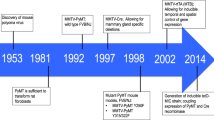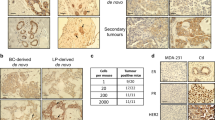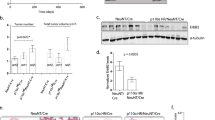Abstract
The ErbB2 receptor tyrosine kinase (RTK) has been intensely pursued as a cancer therapy target due to its association with breast cancer. In this study we used the HC11 mammary epithelial cell line to develop an orthotopic, ErbB2-driven tumor model for testing efficacy of anti-cancer compounds. HC11 cells were infected with a retrovirus encoding oncogenic NeuT, the rat homolog of ErbB2. Drug-selected populations were introduced into mammary fat pads of Balb/c syngeneic mice cleared of host tissue. The majority of glands injected with HC11-NeuT cells developed mammary tumors which appeared after a 3–4 week latency period and grew rapidly. HC11 cells infected with the control retrovirus showed no tumor growth after injection. Tumor-bearing mice were used to compare the in vivo efficacy of two anti-cancer agents: PKI166, a kinase inhibitor selective for EGF receptor and ErbB2, and Taxol®, a microtubule assembly blocker. PKI166 inhibited NeuT-induced mammary tumor growth in a dose-dependent manner and at a dose below the maximum tolerated dose (MTD) was significantly more inhibitory than Taxol® at its MTD (57% vs 25% tumor regression). Importantly, there was a dose-dependent decrease in the phosphotyrosine content of NeuT isolated from PKI166-treated, tumor-bearing mice, providing a mechanistic link between kinase inhibition and its anti-tumor activity. Thus, implantation of genetically manipulated HC11 cells into mammary glands appears to be an excellent model for studying effects of anti-cancer agents in an orthotopic site.
This is a preview of subscription content, access via your institution
Access options
Subscribe to this journal
Receive 50 print issues and online access
$259.00 per year
only $5.18 per issue
Buy this article
- Purchase on Springer Link
- Instant access to full article PDF
Prices may be subject to local taxes which are calculated during checkout





Similar content being viewed by others
References
Ball RK, Friis RR, Schönenberger CA, Doppler W, Groner B . 1988 EMBO J. 7: 2089–2095
Bargmann CI, Hung M-C, Weinberg RA . 1986 Cell 45: 649–657
Barrington RE, Subler MA, Rands E, Omer CA, Miller PJ, Hundley JE, Koester SK, Troyer DA, Bearss DJ, Conner MW, Gibbs JB, Hamilton K, Koblan KS, Mosser SD, O'Neill TJ, Schaber MD, Senderak ET, Windle JJ, Oliff A, Kohl NE . 1998 Mol. Cell. Biol. 18: 85–92
Berger MS, Locher GW, Saurer S, Gullick WJ, Waterfield MD, Groner B, Hynes NE . 1988 Cancer Res. 48: 1238–1243
Bradbury JM, Arno J, Edwards PAW . 1993 Oncogene 8: 1551–1558
Bruns CJ, Solorzano CC, Harbison MT, Ozawa S, Tsan R, Fan D, Abbruzzese J, Traxler P, Buchdunger E, Radinsky R, Fidler IJ . 2000 Cancer Res. 60: 2926–2935
Cardiff RD, Wellings SR . 1999 J. Mamm. Gland Biol. Neoplasia 4: 105–122
Cardiff RD, Anver MR, Gusterson BA, Hennighausen L, Jensen RA, Merino MJ, Behm S, Russo J, Tavassoli FA, Wakefield LM, Ward JM, Green JE . 2000 Oncogene 19: 968–988
Chammas R, Taverna D, Cella N, Santos C, Hynes NE . 1994 J. Cell Sci. 107: 1031–1040
Cobleigh MA, Vogal CL, Tripathy D, Robert NJ, Scholl S, Fehrenbacher L, Wolter JM, Paton V, Shak S, Lieberman G, Slamon DJ . 1999 J. Clin. Oncol. 17: 2639–2648
Cuny M, Kramer A, Courjal F, Johannsdottir V, Iacopetta B, Fontaine H, Grenier J, Culine S, Theillet C . 2000 Cancer Res. 60: 1077–1083
Danielson KG, Oborn CJ, Durban EM, Butel JS, Medina D . 1984 Proc. Natl. Acad. Sci. USA 81: 3756–3760
DeOme KB, Faulkin LJ, Bern HA, Blair PB . 1959 Cancer Res. 19: 515–520
DiGiovanna MP, Lerman MA, Coffey RJ, Muller WJ, Cardiff RD, Stern DF . 1998 Oncogene 17: 1877–1884
Druker BJ, Lydon NB . 2000 J. Clin. Invest. 105: 3–7
Edwards PAW, Hiby SE, Papkoff J, Bradbury JM . 1992 Oncogene 7: 2041–2051
Fabbro D, Ruetz S, Bodis S, Pruschy M, Csermak K, Man A, Campochiaro P, Wood J, O'Reilly T, Meyer T . 2000 Anti-Cancer Drug Design 15: 17–28
Gianni L . 1997 Sem. Oncology 24: S17-91–S17-96
Guy CT, Webster MA, Schaller M, Parsons TJ, Cardiff RD, Muller WJ . 1992 Proc. Natl. Acad. Sci. USA 89: 10578–10582
Humphreys RC, Rosen JM . 1997 Cell Growth & Different. 8: 839–849
Hynes NE, Stern DF . 1994 Biochem. Biophys. Acta 1198: 165–184
Hynes NE, Taverna D, Harwerth I-M, Ciardiello F, Salomon DS, Yamamoto T, Groner B . 1990 Mol. Cell. Biol. 10: 4027–4034
Li B, Rosen JM, McMenamin-Balano J, Muller WJ, Perkins A . 1997 Mol. Cell. Biol. 17: 3155–3163
Medina D . 1996 J. Mammary Gland Biol. Neopl. 1: 5–19
Merlo GR, Venesio T, Taverna D, Marte BM, Callahan R, Hynes NE . 1994 Oncogene 9: 443–453
Morgenstern JP, Land H . 1990 Nucl. Acids Res. 18: 3587–3596
Muller WJ, Sinn E, Wallace R, Pattengale PK, Leder P . 1988 Cell 54: 105–115
Murphy KL, Rosen JM . 2000 Oncogene 19: 1045–1051
Norgaard P, Law B, Jospeph H, Page DL, Shyr Y, Mays D, Pietenpol JA, Kohl NE, Oliff A, Coffey Jr RJ, Poulsen HS, Moses HL . 1999 Clin. Cancer Res. 5: 35–42
Olayioye MA, Neve RM, Lane HA, Hynes NE . 2000 EMBO J. 19: 3159–3167
Pear WS, Nolan GP, Scott ML, Baltimore D . 1993 Proc. Natl. Acad. Sci. USA 90: 8392–8396
Rees CN, Sinnett D, Lowdell C, English J, Coombes RC . 1996 Eur. J. Cancer 32A: 2354–2356
Schroeder JA, Lee DC . 1998 Cell Growth Differ. 9: 451–464
Seidman AD, Tierstan A, Hudis C, Gollub M, Barrett S, Yao TJ, Lepore J, Gilewski T, Carrie V, Crown J . 1995 J. Clin. Oncol. 13: 2575–2581
Siegel PM, Hardy WR, Muller WJ . 2000 BioEssays 22: 554–563
Slamon DJ, Clark GM, Wong SG, Levin WJ, Ullrich A, McGuire WL . 1987 Science 235: 177–182
Smith GH . 1996 Br. Cancer Res. Treat. 39: 21–31
Acknowledgements
We kindly acknowledge the expert technical assistance of F Wenger, L Martinuzzi and W Tinetto. We thank Dr DR Roth for providing information on the tumors from PKI166-treated mice, Dr D Fabbro for the data ErbB kinase inhibition, Dr U Junker and T Bürge for performing the histological analysis, Dr J Mestan for the G410 antibody, and Dr A Racine for the statistical analysis. We appreciate the helpful discussions with Drs T O'Reilly, A Badache, N Li and T Holbro. The laboratory of N.E.H. is supported by the Novartis Research Foundation.
Author information
Authors and Affiliations
Corresponding author
Rights and permissions
About this article
Cite this article
Brandt, R., Wong, AL. & Hynes, N. Mammary glands reconstituted with Neu/ErbB2 transformed HC11 cells provide a novel orthotopic tumor model for testing anti-cancer agents. Oncogene 20, 5459–5465 (2001). https://doi.org/10.1038/sj.onc.1204709
Received:
Revised:
Accepted:
Published:
Issue Date:
DOI: https://doi.org/10.1038/sj.onc.1204709
Keywords
This article is cited by
-
IL-15 augments antitumoral activity of an ErbB2/HER2 cancer vaccine targeted to professional antigen-presenting cells
Cancer Immunology, Immunotherapy (2012)
-
ErbB2 enhances mammary tumorigenesis, oncogene-independent recurrence and metastasis in a model of IGF-IR-mediated mammary tumorigenesis
Molecular Cancer (2010)
-
Targeting the function of the HER2 oncogene in human cancer therapeutics
Oncogene (2007)
-
Inhibition of indoleamine 2,3-dioxygenase, an immunoregulatory target of the cancer suppression gene Bin1, potentiates cancer chemotherapy
Nature Medicine (2005)
-
cDNA microarray analysis of invasive and tumorigenic phenotypes in a breast cancer model
Laboratory Investigation (2004)



